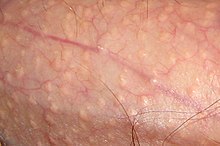Fordyce spots

Fordyce's spots (not to be confused with Angiokeratoma of Fordyce (also known as "Angiokeratoma of the scrotum and vulva"))[1] are small, painless, raised, pale, red or white spots or bumps 1 to 3 mm in diameter that may appear on the scrotum, shaft of the penis or on the labia, as well as the inner surface (retromolar mucosa) and vermilion border of the lips of the face. They are common in men and women of all ages. They are named after an American dermatologist, John Addison Fordyce.[2] On the foreskin they are called Tyson's glands,[3], not to be confused with hirsuties coronae glandis.[4] The spots are a form of ectopic sebaceous gland: normally, sebaceous glands are only found in association with a hair follicle. They are not known to be associated with any disease or illness and are of cosmetic concern only. They aren't infectious and are a natural occurrence on the body. Men sometimes consult with a dermatologist because they are worried they may have a sexually transmitted disease (especially genital warts) or some form of cancer, but this is not the case.[5]
Treatment
Vaporising laser treatments such as CO2 laser[6] or electro desiccation have been used with some success in diminishing the appearance of this condition if they are of cosmetic concern, despite the fact that most doctors consider this a normal physiological phenomenon and advise against treatment.[citation needed]
Success varies per patient, but some have found relief from pulse Dye Lasers,[7] a laser normally used to treat sebaceous gland hyperplasia,[8] which is similar to Fordyce spots. Treatment with Pulse Dye Lasers might be expensive but doesn't scar.[9]
See also
- Angiokeratoma of Fordyce
- List of cutaneous conditions
- List of specialized glands within the human integumentary system
References
- ^ James, William; Berger, Timothy; Elston, Dirk (2005). Andrews' Diseases of the Skin: Clinical Dermatology. (10th ed.). Saunders. ISBN 0-7216-2921-0.
- ^ synd/1510 at Who Named It?
- ^ derm/395 at eMedicine
- ^ Khoo LS, Cheong WK. Common genital dermatoses in male patients attending a public sexually transmitted disease clinic in Singapore. Ann Acad Med Singapore 1995;24:505-9.
- ^ Palo Alto Medical Foundation Bettina McAdoo , M.D. Retrieved June 24, 2006.
- ^ Ocampo-Candiani J, Villarreal-Rodriguez A, Quinones-Fernandez AG, Herz-Ruelas ME, Ruiz-Esparza J. Treatment of Fordyce spots with CO2 laser beam. Dermatol Surg 2003; 29: 869-71. PMID 12859392
- ^ http://sebaceous.proboards42.com/index.cgi?board=real&action=display&thread=249&page=5
- ^ Schönermark MP, Schmidt C, Raulin C (1997). "Treatment of sebaceous gland hyperplasia with the pulsed dye laser". Lasers Surg Med. 21 (4): 313–6. PMID 9328977.
{{cite journal}}: CS1 maint: multiple names: authors list (link) - ^ http://www.ncbi.nlm.nih.gov/pubmed/9328977?dopt=Abstract
